HARALD THYS
Even though Harald Thys is best known for his videos, there is much more to his body of work. Thys works with paper, for instance, with pencil and ballpoint, he makes simplistic drawings of fictitious characters – hybrids between people, animals and clowns or freaks – he writes short, bittersweet fragments about their course of life and the events in their lives. He also produces site-specific installations which question the physical environment as the functionality and the allocation of a building/ institute, for instance Domus Kartonus in 2002 in the Ghent Bijlokemuseum. There he engrossed himself over a period of several months in the building with its rooms and its people; he observed and analysed how the historical city museum operated on a daily basis. Thys’s intervention was radical: most of the objects – paintings, books, guns, and the like – were removed from their showcases and stored away. The few objects which remained were given a new, according to the artist ‘more natural type of’ trajectory: a neat architecturally developed structure in wood and mainly cardboard created a fictitious museum, a preliminary mental construction. At the same time the administrative apparatus of the museum was converted into a fictitious centre for research in which museum publications as well as the computer database of the collection were available for consultation.
The dry ironical overtones Domus Kartonus incorporated – some of the objects were even displayed in a deliberately pompous way – is echoed in the ever well-considered scenography of Thys’s films. This aspect becomes most clear in Crotus Pilarus, a chilly and minimalist observation of a house, its various rooms, the discussions between two men and a woman. The camera is used as a silent observer, staying at a distance, carefully framing delineating empty spaces, lifeless ornaments and a human presence. In The Corpse too, in which a simple storyline about a depressive farmer is used as a metaphor for a universal consideration, Man is but one element in his physical surroundings, a sign of life, a bundle of emotions. The ’condition humaine’ under consideration is reinforced by the as oppressive as hilarious and nostalgic aesthetics of the costumes and the background – a sparse little table, Bayern Stühlen and an old bed – the scenery the artist set up after his research on German interiors. These paradoxical emotions are sometimes continued by the artist in his accounts and his dialogues: in The Seamen and the Ship, in which two former sailors muse on their past from their apartment with a view on the sea wall, the lines resound deliberately slowly and sec, skating on a thin line between pathos, autism and genuine homesickness. In his videos Thys tries to evoke a maximum of theatrical ambiguity with utterly simple, often clichéd elements.
Beside his solo work, Harald Thys has since the second half of the eighties also produced visual work, works on paper, videos and sound art in collaboration with Jos De Gruyter. Even though the artists are best known for their audiovisual productions, these works are inextricably bound up with their realisations in other media. Their whole body of work is characterised by burlesque friskiness and an almost childlike simplicity with humorous effect; nevertheless it always embodies a dark strand of paradoxical emotions or critical reflections.
For the most part their videos start from trivial and almost corny situations and actions: a discussion between a man and a woman, who are trying to embellish their house (The Bucket) or a fairytale story (The Curse). These extremely familiar situations and fictitious observations are disrupted time and again by the artists. To this purpose the duo makes use of a series of techniques which they have derived from the dramaturgical jargon of theatre and TV-shows for children. For their mutual video works, for instance, they erect very tight backgrounds, nearly minimalist because of their predominant greyscales. They are at right angles with the almost distressingly intimate way in which the characters deal with one another, an aspect which is reinforced by their clothes with an often familiar feel. This intimacy between the actors –often, by the way, Thys’ brother and sisters and half-brothers of the De Gruyter – is continued in the unnervingly slow utterance of the dialogues, which are just as basic, and the childlike, simple actions they perform - at a similarly slow pace. The repositioning of actors with family bonds in new, unfamiliar surroundings produces unexpected results. In fact they are reduced to stereotypes: a victim, an executioner, an autistic man, a lunatic, et cetera.
The videos of De Gruyter and Thys balance on the verge of alienation: the strongly pronounced, exaggerated gestures, the sober settings and characters that are leaning towards apathy, degenerated characters, wandering about in an isolated world of their own. To them the outside world is unthinkable; as if there is a vacuum outside of these rooms or, at best, an imminent, invisible threat.
Furthermore the twosome sticks to tight, very dry camera manipulations. The camera records from a safe, at times somewhat uneasy distance, from a steady position. The spectator becomes accessory to the actions which take place: he is turned into a voyeur, limited to observing, as powerless as he is amused with the game between the vulnerable, though emotionally paradoxical and the characters, who are harder and harder to grasp.
Another segment of the video work by De Gruyter and Thys turns to established, documentary lines, though even they are carefully staged. The Bomb, for instance, pursues a man who is preparing a bomb in his garden, where he lets it explode. The camera records most carefully, narrowly tracing the fictitious character, as if it were a report.
In some cases the duo resorts to historical figures. Here the artists manipulate their subjects from within by embodying them. Uit het leven van P.P. Rubens, for instance, brings together five fictitious scenes ‘from the daily life’ of P.P. Rubens and his two assistants Snyers and Van Dijck. Pegged down along the established lines of narrator and dialogue – the standard parameters within the genre – De Gruyter and Thys deliver a pastiche of the life and day-to-day worries of the three famous painters.
The content of De Gruyter and Thys’s works in other media – from drawings on paper to plasticine dolls and computer graphics – is connected to their video work. In 1993, for instance, they put together the exhibition Keizer Ro (ICC, Antwerp and Foncke, Ghent), about a fictitious emperor who hurls Belgium into chaos in three months’ time with his acts and his theories. Apart from an extensively documented exhibition of portraits of all of Emperor Ro’s subjects, the twosome exhibited video works after the three networks the leader set up in his empire: a jokes network, a war channel, and a teletext service from which subjects could make out, depending on the colour in which their name appeared onscreen, whether they were up for execution or not. This ensemble of works also mingled observation, manipulation of feelings and historical references with implicit media criticism.
Harald Thys studied at the Sint-Lukas institute in Brussels and the Jan van Eyck Akademie in Maastricht. His installations and videos are often made in collaboration with Jos De Gruyter. His work has been shown, among other places, in the Irish Museum of Modern Art (Dublin), CRAC Sète (France), de Singel (Antwerp), the Middelheim Museum (Antwerp) and the Kunsthalle Basel.
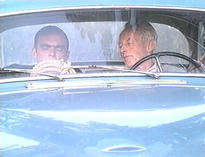
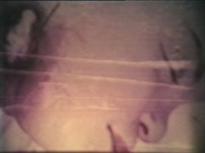
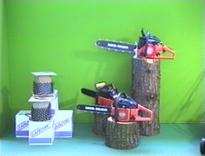
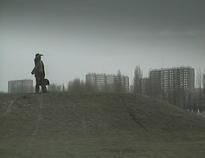
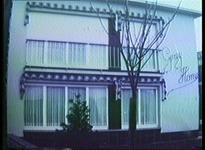
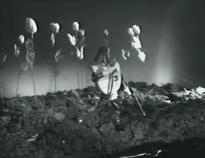
- ° 1966 Wilrijk (Belgium).
-
EVENEMENTEN
- FILM COLOGNE - Flanders Moving Image
- Real to Reel
- Grinding away at the boundaries. Recent videos from Belgian Visual Artists
- Biennale de l'Image en Mouvement 1999
- A world of objects
- STEP UP! Belgian Dance and Performance on Camera 1970-2000 - Chapter 3
- COM nu TIES seuils/drempels/thresholds - A duoshow with ISELP
-
At view in the media library
WERKEN- Crotus Pilarus
- De geschiedenis van Mr. Kroll
- De vergeetput
- De zeemannen en het schip
- Die Leiche im Bayerischem Walt
- Dimbu
- Enthalte am Totenmehr
- Het geel van Gent
- Het slachtoffer
- Housegame
- Landbouwsalon
- Parallelogram
- Planet-X
- The Conversation
- The Curse
- The Deserter
- The Spinning Wheel
- Whymper: de schetsende bergbeklimmer
- Zonder Titel